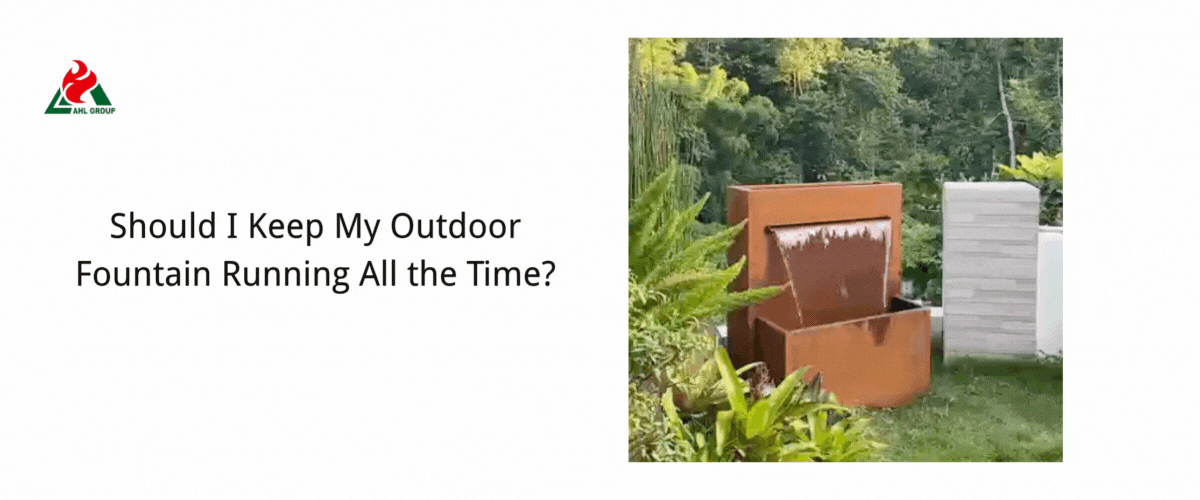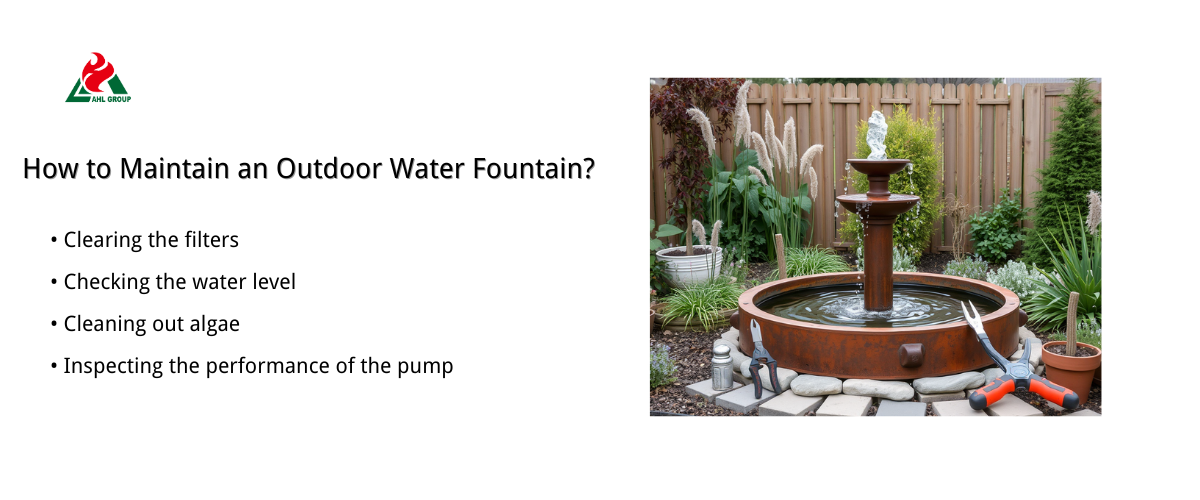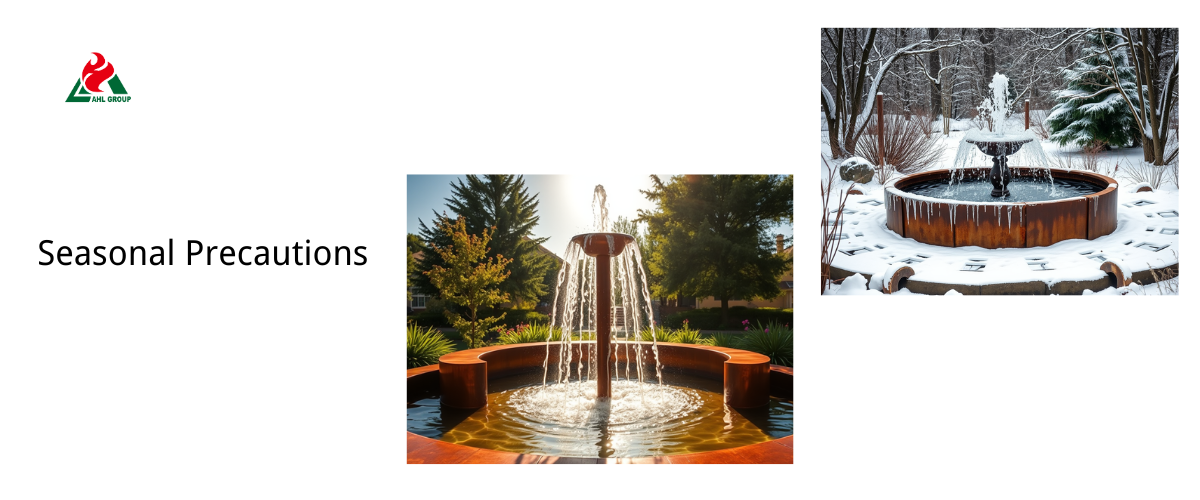Outdoor water fountains become more than just ornamental components - they are also dynamic centerpieces that elevate garden aesthetics, calm the senses, and create a serene environment. Installed in residential backyards, commercial patios, or public spaces, water features take careful handling to maximize their performance and longevity.
One common question asked by homeowners, landscape architects, and facility managers is, “Should I keep my outdoor fountain running all the time?"
In this detailed guide, we'll explore the strengths of running continuously, factors that affect this determination, energetic and maintenance implications, seasonal conservation, and expert insights designed to help you make the smartest choice for your water feature.

As a major benefit of keeping a fountain running is the continuous recirculation of the water. Standing water will rapidly become stagnant, particularly in warmer temperatures, resulting in a cloudy appearance, bad odor, and increased risk of algae and bacterial growth. Flowing water will maintain ventilation, thereby improving the oxygen levels and suppressing microbial activity.
Benefits: Maintaining a running fountain will help to keep the quality of the water clear and healthy, decreasing the demand for chemical treatments.
Mosquitoes demand peaceful standing water to lay their eggs. Constantly circulating water in a fountain destroys this breeding environment. During the summer months in particular, this would be a creative way to control mosquitoes naturally with no need for insecticides.
Benefit: Continuous water flow will reduce mosquito numbers and help preserve outdoor spaces from pests.
Consistent streaming water sounds are calming to the senses and add auditory texture to any landscape. Additionally, flowing water sounds will add a visual element of movement - especially during the night when paired with lighting fixtures. At all times, fountains maintain a continuous atmosphere that elevates the outdoor living area.
Benefits: Increased visual attractiveness and a peaceful all-weather environment.
Allowing a fountain to run over the winter in cold climates, particularly in areas where temperatures fall below freezing, has the potential to cause serious damage. Remaining water in pipes, bowls, or pumps can freeze and expand, causing fractures and mechanical failures. In this case, it is imperative to winterize the fountain - draining the water, storing the pump, and covering the fountain.
During warmer climates, it is more feasible, even encouraged, to operate continuously to prevent overheating or debris buildup.
Tip: Evaluate your local seasonal temperatures and be prepared accordingly.
Fountain construction, size, and materials are significant. Large fountains with several pools or fountains with a vertical drop may need more powerful pumps and drainage systems, which result in higher energy consumption. On the other hand, smaller fountains, typically those that are solar-powered or gravity-fed, are much more energy-efficient and are suitable for all-weather operation.
The use of fountains manufactured from materials such as Corten steel, which offers resistance to corrosion and weathering, can also affect this decision. Corten steel is perfect for fountains designed to run outdoors for extended periods.
Leaves, dust, and debris like pollen can accumulate even with continuous operation. Routine maintenance is necessary, including:
• Clearing the filters
• Checking the water level
• Cleaning out algae
• Inspecting the performance of the pump
Operating a fountain around the clock can minimize a lot of standing water, but it does not remove the need for regular maintenance.

Electrical costs are a primary concern for homeowners and commercial property managers. Typical small fountain pumps use 10-50 watts of power per hour. Operating a pump continuously can add $3-10 to a monthly energy bill, based on local rates and pump capacity.
Large systems, as well as those with built-in lighting, can cost much more, so energy efficiency is a key consideration. Be sure to check the fountain pump's energy efficiency level before making the decision to use it around the clock.
To minimize energy consumption while not compromising water quality, install timers or smart controllers. Such devices can be automated:
• Operating the fountain during peak hours (morning and evening)
• Turning off at night or when no one is around
• Adapt the efficiency to the season or the weather
Modern pumps also come with an eco-mode, which reduces energy consumption while maintaining circulation.
During areas with severe winters, it is recommended that the following measures be taken:
• Shut down the fountain in late fall
• Empty the system of all water
• Remove and clean the pump
• Keep the equipment indoors
• Put a breathable, waterproof cover over the fountain
This will prevent frost damage, cracking, and corrosion.
In the hot season, fountains help keep the surrounding area cool and maintain humidity. Running the fountain for extended periods during the summer can prevent stagnation from evaporation and maintain the oxygen content of the water - this is particularly relevant when outdoor use is increased.

Landscape Architects
Many landscaping experts suggest continuously running fountains- particularly for public spaces or high-end residential spaces, as their aesthetic impact is critical. Seeing and hearing the sights and sounds of running water delivers a sensory richness that is lacking in static landscapes.
Maintenance Technicians
Service experts emphasized that although continuous running can minimize problems like algae growth, the need for periodic maintenance is not eliminated. They often advise the balance between cleaning and affordability by working with timers in residential applications.
The ability to consistently operate an outdoor fountain is dependent on several factors - weather, fountain design, energy use, and maintenance capabilities. Although there are a few distinct advantages of running consistently, working smart with tools such as timers, high-efficiency pumps, as well as seasonal tactics, may help to counterbalance performance and cost.
Recommendation:
• In Warm Temperate Regions: Ongoing operation is often beneficial.
• In Cold Climates: Significant seasonal downtime is essential to prevent damage.
• For Large or Commercial Fountains: Sequential operation enhances results and reduces stagnation.
• Optimize performance and energy use with a timer or intelligent system.
• Choosing durable materials, such as Corten steel, will ensure prolonged weather resistance and low maintenance costs.
Looking for a water feature that pairs industrial durability with modern elegance? Our Corten steel water fountains have been designed for extended outdoor use, providing rust-proof aesthetics, architectural integrity, and minimum maintenance costs. Drawing on many years of combined experience and global exports, we assist landscape professionals, wholesalers, and brand owners in achieving the perfect outdoor landscape.
One common question asked by homeowners, landscape architects, and facility managers is, “Should I keep my outdoor fountain running all the time?"
In this detailed guide, we'll explore the strengths of running continuously, factors that affect this determination, energetic and maintenance implications, seasonal conservation, and expert insights designed to help you make the smartest choice for your water feature.

Benefits of Keeping Your Fountain Running
✅ Water Quality: Prevents Stagnation and Algae Growth
As a major benefit of keeping a fountain running is the continuous recirculation of the water. Standing water will rapidly become stagnant, particularly in warmer temperatures, resulting in a cloudy appearance, bad odor, and increased risk of algae and bacterial growth. Flowing water will maintain ventilation, thereby improving the oxygen levels and suppressing microbial activity.
Benefits: Maintaining a running fountain will help to keep the quality of the water clear and healthy, decreasing the demand for chemical treatments.
✅ Pest Control: Prevents Mosquitoes from Breeding
Mosquitoes demand peaceful standing water to lay their eggs. Constantly circulating water in a fountain destroys this breeding environment. During the summer months in particular, this would be a creative way to control mosquitoes naturally with no need for insecticides.
Benefit: Continuous water flow will reduce mosquito numbers and help preserve outdoor spaces from pests.
✅ Aesthetic and Sensory Enjoyment
Consistent streaming water sounds are calming to the senses and add auditory texture to any landscape. Additionally, flowing water sounds will add a visual element of movement - especially during the night when paired with lighting fixtures. At all times, fountains maintain a continuous atmosphere that elevates the outdoor living area.
Benefits: Increased visual attractiveness and a peaceful all-weather environment.
Factors to Consider Before Continuously Running a Fountain
Climatic Conditions
Allowing a fountain to run over the winter in cold climates, particularly in areas where temperatures fall below freezing, has the potential to cause serious damage. Remaining water in pipes, bowls, or pumps can freeze and expand, causing fractures and mechanical failures. In this case, it is imperative to winterize the fountain - draining the water, storing the pump, and covering the fountain.
During warmer climates, it is more feasible, even encouraged, to operate continuously to prevent overheating or debris buildup.
Tip: Evaluate your local seasonal temperatures and be prepared accordingly.
Fountain Design and Types
Fountain construction, size, and materials are significant. Large fountains with several pools or fountains with a vertical drop may need more powerful pumps and drainage systems, which result in higher energy consumption. On the other hand, smaller fountains, typically those that are solar-powered or gravity-fed, are much more energy-efficient and are suitable for all-weather operation.
The use of fountains manufactured from materials such as Corten steel, which offers resistance to corrosion and weathering, can also affect this decision. Corten steel is perfect for fountains designed to run outdoors for extended periods.
Maintenance Requirements
Leaves, dust, and debris like pollen can accumulate even with continuous operation. Routine maintenance is necessary, including:
• Clearing the filters
• Checking the water level
• Cleaning out algae
• Inspecting the performance of the pump
Operating a fountain around the clock can minimize a lot of standing water, but it does not remove the need for regular maintenance.

Energy and Cost Impacts
Electricity Consumption and Financial Impacts
Electrical costs are a primary concern for homeowners and commercial property managers. Typical small fountain pumps use 10-50 watts of power per hour. Operating a pump continuously can add $3-10 to a monthly energy bill, based on local rates and pump capacity.
Large systems, as well as those with built-in lighting, can cost much more, so energy efficiency is a key consideration. Be sure to check the fountain pump's energy efficiency level before making the decision to use it around the clock.
Smart Alternatives: Timers and High-Efficiency Pumps
To minimize energy consumption while not compromising water quality, install timers or smart controllers. Such devices can be automated:
• Operating the fountain during peak hours (morning and evening)
• Turning off at night or when no one is around
• Adapt the efficiency to the season or the weather
Modern pumps also come with an eco-mode, which reduces energy consumption while maintaining circulation.
Seasonal Precautions
❄️ Winter Considerations and Storage
During areas with severe winters, it is recommended that the following measures be taken:
• Shut down the fountain in late fall
• Empty the system of all water
• Remove and clean the pump
• Keep the equipment indoors
• Put a breathable, waterproof cover over the fountain
This will prevent frost damage, cracking, and corrosion.
☀️ Summer Operation
In the hot season, fountains help keep the surrounding area cool and maintain humidity. Running the fountain for extended periods during the summer can prevent stagnation from evaporation and maintain the oxygen content of the water - this is particularly relevant when outdoor use is increased.

Expert Advice: Advice from the Pros
Landscape Architects
Many landscaping experts suggest continuously running fountains- particularly for public spaces or high-end residential spaces, as their aesthetic impact is critical. Seeing and hearing the sights and sounds of running water delivers a sensory richness that is lacking in static landscapes.
Maintenance Technicians
Service experts emphasized that although continuous running can minimize problems like algae growth, the need for periodic maintenance is not eliminated. They often advise the balance between cleaning and affordability by working with timers in residential applications.
Final Verdict: Should You Always Run Your Fountain?
The ability to consistently operate an outdoor fountain is dependent on several factors - weather, fountain design, energy use, and maintenance capabilities. Although there are a few distinct advantages of running consistently, working smart with tools such as timers, high-efficiency pumps, as well as seasonal tactics, may help to counterbalance performance and cost.
Recommendation:
• In Warm Temperate Regions: Ongoing operation is often beneficial.
• In Cold Climates: Significant seasonal downtime is essential to prevent damage.
• For Large or Commercial Fountains: Sequential operation enhances results and reduces stagnation.
• Optimize performance and energy use with a timer or intelligent system.
• Choosing durable materials, such as Corten steel, will ensure prolonged weather resistance and low maintenance costs.
Learn About Our Corten Steel Fountain Solutions
Looking for a water feature that pairs industrial durability with modern elegance? Our Corten steel water fountains have been designed for extended outdoor use, providing rust-proof aesthetics, architectural integrity, and minimum maintenance costs. Drawing on many years of combined experience and global exports, we assist landscape professionals, wholesalers, and brand owners in achieving the perfect outdoor landscape.


